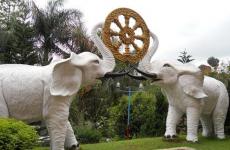Training "Slimness" weight harmonization based on the psycho-correction of eating behavior. Training for the correction of psychomotor and sensory processes "visiting autumn" Training for correction
Tatiana Pavlova
Training "Correction of fears with the help of art-therapeutic methods"
I would like to bring to your attention training which I spent with colleagues: pedagogues-psychologists of our district. Also this training can be adapted for older children.
Concept. At the core fear as a basic human emotion lies the instinct of self-preservation. It should be noted that fears may not have these positive functions, and then they become signals of personal trouble. fears accompanied by dysfunctional manifestations in the form of chronic emotional dissatisfaction, dejection, general lethargy, irritability, anxiety. There are various types of therapy that are used in practical work with fears. Application art therapy exercise is indispensable in cases of emotional disorders (fear, anxiety)
Target: overcoming fears through art therapy.
Tasks:
Increasing self-confidence;
Formation of a positive I-concept;
Overcoming negative experiences;
Decreased emotional stress.
Estimated result: Members training learn to overcome fears with the help of art therapy methods.
Material and equipment: colored pencils or felt-tip pens, A4 paper.
Forms of work: art therapy
Number of participants:
Main part.
Introduction. (Mini-lecture)
Today we will look at ways to overcome fears and anxiety in people with using the art therapy method expressive drawing. Expressive drawing is a safe way "chill out" and relieve tension. WITH help visual images, it is easier for the participant to express unconscious internal conflicts and fears than to put them into words. Art therapy exercises serve as a means of free self-expression and self-knowledge, suggest an atmosphere of trust, attention to man's inner world.
Immediately we will stipulate the rules that we will adhere to throughout classes:
open communication
activity
non-judgmental judgments
voluntary participation
Here and now
Acquaintance (waiting collection):
I propose to start our training with acquaintance and expectations from the upcoming training.
Exercise "Our Expectations"
Target: revealing the expectations of the participants. Request correction.
At the end training we will have the opportunity to analyze your expectations. Now, we are moving on to an exercise called "Magic Mirrors".
Exercise "Magic Mirrors"
Target: the formation of a positive self-concept, increased self-confidence, reduced anxiety.
You are invited to draw yourself in 3 mirrors, but not simple ones, magical: in the first - small and frightened, in the second - large and cheerful, in the third - not showing anything and strong.
Now everyone should submit their drawing and answer the following questions.
1. Which person looks prettier?
2. Who do you look like now?
3. In what mirror do you most often look in your life?
4. Who would you like to be like?
5. What feelings did you have in the process of drawing 3 drawings?
Exercise 2. "Draw your fear»
Target: overcoming negative experiences, symbolic destruction fear, reducing emotional stress.
Now, I suggest you draw your fear. And then, take turns talking about your drawings.
1. What is shown in the picture? Tell me more about him.
2. What did you feel while drawing?
I offer you several options to choose from getting rid of your fear: destroy drawing (fear) ; turn scary to funny by completing the drawing; decorate it so that it pleases itself and becomes good; Or come up with your own version.
Questions:
1. What is the way to get rid of the fear you chose?
2. What feelings did you have during "deliverance"?
3. Has your attitude towards this fear now?
Conclusion.
We are finishing our lesson here and now, I want to thank all the participants of our lesson, please tell us how you feel, whether your expectations from today's lesson were justified.
Program"Correction of aggressive behavior of teenagers"
The manifestation of aggressiveness in a child can be observed from a very early age, it is associated with anxiety, has a certain value for survival.
But in full measure, his reactions to discomfort cannot yet be classified as aggressive acts, since the child does not have the goal of harming other people or objects. The initial aggressive manifestations have a communicative function and their further development depends on the attitude of the closest adults towards them, and then on the wider environment.
Normal development and functioning of a person is possible only if he has formed a positive attitude towards himself. When studying persons characterized by associative behavior, their following features were revealed:
Lack of necessary social skills;
Inability to express anger, irritation in socially acceptable forms;
Immaturity of outlook on life and relationships with other people;
Diffidence.
The problem of aggressive behavior in children and adolescents is very relevant today, especially if these children are brought up in an orphanage. There are many factors that contribute to the manifestation and development of aggressiveness (a large number of people, the inability to retire, the desire to defend one's "I" in the team). Working on the topic of self-education "Adolescent aggressiveness as a problem of interpersonal relations", as well as having carried out diagnostic work with a group of children, I compiled the program "Correction of aggressive behavior of adolescents".
This program is focused on corrective work with children in whose behavior certain aggressive manifestations are observed. Unlike programs that are aimed at correcting the emotional sphere of children, where only some exercises are included to reduce aggressive manifestations, this program is fully aimed at working with aggressive manifestations that occur in children in an orphanage.
Program goal: psychological support for children with various aggressive manifestations.
In the process of implementing the program for the correction of aggressive behavior of children, it is planned to solve the following tasks:
1) Help children to realize the negative aspects of their behavior, manifested in anger, cruelty, aggressiveness.
2) Teach children constructive behavioral responses in a problem situation.
3) Teach how to respond (express) your anger in an acceptable way for yourself and others.
Program effectiveness criteria:
1) Reduce the level of personal anxiety;
2) Actualize aggressiveness as an unacceptable form of communication;
3) Exercise control over aggressive behavior;
4) Increase self-confidence.
Stage 1 - Diagnostic. At this stage, it is supposed to conduct a diagnostic study of a group of adolescents whose behavior is one way or another manifested by aggressiveness. For diagnosis, you can use the following methods:
1) Questionnaire "Signs of aggressiveness" (Performed by the teacher after observing a group of children for 6 months).
Rostov n / a: Phoenix, 2014. - 254 p. — (Psychological workshop). - ISBN 978-5-222-22218-8. The book presents a variety of training, psychotherapeutic exercises, role-playing games and techniques that can be used in practical work with adults. Particular attention in the book is paid to work with various spheres of people's life. In particular, the problems and methods of work associated with personal, interpersonal development and the emotional sphere of a person are considered. The book also contains exercises and role-playing games, the purpose of which is to correct problems that are relevant for many clients in the field of professional activity: professional adaptation, professional identity, professional competence, team building. The book can be useful to practical psychologists, teachers, lecturers and students of psychological faculties. Introduction. The concept and types of psycho-correctional work. Psychological problems of clients.
and how to work with them.
The concept and types of psycho-correctional work.
Correlation of the concepts "psychological correction", "psychotherapy", "psychological training".
Goals and objectives of the psycho-correctional process. Basic methods, methodological techniques and techniques of group psycho-correction.
Basic methods of group psycho-correction.
Additional psycho-corrective methods and techniques. Specifics of psycho-correctional work with adults. Psychological problems of clients and methods of working with them.
Specificity of psycho-correctional work with adults.
Psychological problems of clients and methods of working with them.
Correction of the emotional and motivational sphere.
Correction of the sphere of interpersonal relations.
Personal development and personal growth.
Correction of professional identity, adaptation and competence. Exercises, role plays and techniques in working with adults.
Trainings for the correction of the emotional sphere.
Training exercises to reduce psycho-emotional stress.
Exercise "Muscular gymnastics".
Exercise "My tension".
Exercise "Unwinding the ball."
Exercise "Autogenic training for beginners."
Exercise "Revitalization of the body."
Exercise "Clamp".
Exercise "Fly in captivity."
Sleep exercise.
Exercise "Electric current".
Exercise "Sounding Body"
Exercise "Swing".
Exercise "Plasticine man".
Exercise "Stressed postures".
Exercise "I draw inner speech."
Exercise "The ship on which I am sailing."
Exercise "Mountain peak".
Exercise "Orange glasses".
Exercise "Pleasant color".
Exercise "Goldfish".
Exercise "Niches of pleasure."
Exercise "Good in moss."
Autogenic training exercise.
"Control of vascular tone of the head".
Exercise "Free body".
Exercise "Working with smells". Exercises for training to overcome loneliness and negative emotional.
states.
Exercise "Working with negative states."
Exercise "Egocentrism".
Exercise "Rose bush".
Exercise "Game with anxiety."
Exercise "Dream Island"
Exercise "Optimistic listening".
Exercise "My successes and my failures."
Exercise "Associated states".
Exercise "Optimist, pessimist, jester."
Exercise "Feelings and sensations."
Exercise "Emotional partner".
Exercise "Combination of colors."
Exercise "Give and Receive".
Exercise "What gives me pleasure?".
Exercise "New Place" Trainings for the correction of interpersonal relations.
Exercises and techniques for correcting disorders and difficulties in communication.
Exercise "Presentation" (with video recording).
Role-playing game "Home Pedagogy" (with video recording).
One way contact exercise.
Exercise "How to learn to give and receive signs of attention."
Exercise "Difficult conversation" (with video).
Exercise "Unsure, confident and aggressive answers."
Role-playing game "Smoothing conflicts".
Exercise "Infernal Towers".
Exercise "Assertive request".
Assertive refusal exercise.
Exercise "I say what I see."
Justification exercise.
Exercise "Fairy tale in a circle."
Exercise "Puppet".
Exercises and techniques for developing effective communication skills (communicative competence training).
Exercise "Self-assessment".
Exercise "Through glass".
Exercise "Discussion".
Exercise "Assimilation of the effectiveness of non-verbal communication" (video).
Exercise Yes.
Exercise "Dispute".
Exercise "Dispute in front of a witness."
Exercise "Pass the information."
Exercise "Images".
Exercise "Hedgehog".
Interview exercise.
Exercise "I understand you."
Exercise "Find a couple."
Exercise "Desire"
Exercise "Gift of Persuasion"
Exercise "Give me an apple."
Exercise "Out of contact".
Exercise "Conversation in different positions."
Exercise "Motivation to action."
Exercise "Ivan Petrovich".
Exercise "Objects".
Exercise Request.
Exercise Tell a story.
Exercise "Tell me about the problem."
Exercise “Talking in pairs”.
Exercise on the phone.
Exercise "Blind and guide."
Exercise "Valuable quality".
Exercise "Community of Interests". Personal sphere correction training.
Personal Growth Training.
Exercise "Introduction".
Exercise "My physical self".
Exercise "Who am I?"
Exercise "My strengths."
Exercise "Without a mask."
Exercise "Who I like and who I don't like."
Exercise "Do you recognize me?".
Exercise "Motto".
Exercise "The Tale of the Magician".
Exercise "Self-portrait".
Exercise "Magic shop".
Exercise "Marriage Announcement".
Exercise "Sage from the temple."
Exercise "Counterarguments".
Exercise "Rewritten autobiography".
Exercise "Project biography".
Exercise "You can't praise yourself."
Exercise "Metaphor of the problem."
Exercise "T-shirt hippie." Creativity Training Exercises.
Exercise "The World of Mathematics".
Exercise "Creative person".
Exercise "Drawing creativity".
Exercise "Guess the word."
Exercise "Non-standard way".
Exercise "Ideas, principles, habits."
Exercise "Creative tasks".
Exercise "Cube".
Exercise "Such a different orange."
Exercise "Prediction".
Exercise "Creative Journey"
Exercise "Improbable situation".
Association exercise.
Exercise "Alphabet".
Exercise "Images".
Exercise "Interesting adjectives."
Exercise "Creative visualizations".
Exercise "Group associations".
Exercise "My drawing".
Exercise "Who am I?"
Exercise "Architectural structure". Professional Development Trainings.
Training exercises for professional adaptation, professional identity.
and professional competence.
Role-playing game "Promotion and dismissal".
Exercise "Find out the problems of others."
Exercise "A Little Better"
Exercise "Human Resources".
Exercise "Public interview".
Exercise "Sand or stone?".
Exercise "Portrait of my work."
Exercise "You can't waste a second."
Exercise "Moving".
Exercise "Features of a career."
Exercise "Empty room".
Visual-reflexive exercise "Vocation".
Exercise "Plan my future."
Exercise "If., I would become.".
Exercise "My life and professional plans."
Profigra "Court on the Unemployed".
Exercise "Creative success".
Exercise "5 steps".
The game "Traps-traps".
Exercise "Star hour".
Exercise "A Day in the Life"
Exercise "My favorite work." Team Building Training Exercises.
Exercise "Getting to know each other"
Team name exercise.
Connection exercise.
Team leader exercise.
Exercise "Raccoon circle".
Exercise "Invisible connection".
Exercise "Movement".
Exercise "Puzzle".
Exercise Siamese twins.
Exercise "Seating according to the sign."
Exercise "Group house".
Exercise Tree of Success.
Exercise "List of common qualities."
Exercise "Fingers"
Sociogram exercise.
Exercise "Find common ground".
Exercise "Creating a team motto."
Absorption exercise.
Support exercise.
Exercise "Break into the circle."
Training technique "Dog Harry". Literature.
Extra pounds do not go away?
Do constant dieting failures make you feel guilty?
Not enough energy for fitness?The best way to get rid of extra pounds is to leave them on your plate!
Do you want to do it yourself manage your« perfect» weight?
 With many diets and weight loss programs, our country does not become less overweight people. There are more and more of them. So it's good for someone. Paranoia about food has long become widespread and has crossed the boundaries of healthy reality.
With many diets and weight loss programs, our country does not become less overweight people. There are more and more of them. So it's good for someone. Paranoia about food has long become widespread and has crossed the boundaries of healthy reality.
Training "Slimness" is not a diet and not a "correct" sports or low-calorie diet. Our training is an opportunity to look from the other side at your relationship with food, a new approach to life, a way of life. And it's not for a while, it's forever if you accept the training program. Our program is maximally permissive and the main task is to remove the accumulated stress associated with food. Realize that food is not our enemy or friend, comforter, cure for life's difficulties or pleasure, etc. Food is a source of energy for our body and nothing else, without which it cannot function effectively.
 An eating disorder is a mental disorder in which a person eats food not to satisfy hunger, but to cheer up and get pleasant emotions. For people with food addiction, food helps to cope with excitement, anxiety, it helps to relieve stress.
An eating disorder is a mental disorder in which a person eats food not to satisfy hunger, but to cheer up and get pleasant emotions. For people with food addiction, food helps to cope with excitement, anxiety, it helps to relieve stress.
Why is this happening? Because the feeling of “emptiness” inside a person, which he tries to fill with food, leads to falling into “bondage”. The body can confuse the sensations that arise from mental experiences with signals of hunger, which leads to haphazard eating and overeating.
Psychological problems that prevent you from finding an ideal figure.Eating Disorders removable but it requires responsible work and personal motivation.
- Do you often continue to eat after you feel comfortably full?
- Do you often overeat before you start a new diet (realizing that on a diet you can not afford to eat all this for a long time)?
- Do you sometimes eat to cope with emotions or to fight boredom?
- Are you one of those who consistently dislike physical activity?
- Do you only exercise when you are on a diet?
- Do you often skip meals or only eat when you are literally dropping from hunger and end up overeating?
- Do you feel guilty if you overeat or eat "unhealthy food", which eventually leads to more overeating (it's all gone anyway)?
If you answered “yes” to all or some of these questions, your current weight may be higher than your physiological weight, which your body has been programmed to maintain on its own from birth, without additional effort on your part. It is very likely that you will be able to return to this weight. The most important thing to remember is that weight loss SHOULD NOT be an end in itself, as eating for weight loss will greatly hinder your ability to listen to your body's internal signals.
Psychology of Slimness
Do you think that for this you need to have an "iron" character?
But it's not!
If we eat on time and in the amount our body needs, then all systems work smoothly. Our body has the necessary energy at the right time, does not work with overload, processing excess food, does not store energy in reserve. In this case, we always have a normal weight. When we limit ourselves, eat low-calorie food, then we have a constantly starving body, living with a constant lack of energy. This is an organism that constantly finds something somewhere, takes energy from one system and transfers it to another. The moment will come and the body can not cope, some system of the body will fail.
Each organism has its own normal weight. It is known that in order for a woman to become pregnant, she needs to be a little in the body. That is, to accumulate additional energy for new processes in the body. Lack of weight leads to the fact that the body cannot function as healthy.
Our body has biological needs. These include sleep, breathing, sex, excretion of waste products, eating and drinking, etc. With food addiction, the connection with our body is disrupted and then we cannot determine when energy is needed for our body.
We decide to eat or not to eat, what to eat, what calorie content is rational, without taking into account the true needs of our body. And we are always wrong.
Our body is a huge chemical laboratory. At the right time, he makes an analysis and understands which chemical element or substance is missing or required by our body. At the cellular level, he knows what product he needs right now. But if the connection is broken, we cannot hear these signals. If now our body needs a small piece of butter, and we shove lettuce into it, because we think it is useful, we are not in contact with our body. Our body is depleted over time, because it does not receive what it needs and in the right amount.
Our body has its own wisdom. Try to feed a newborn baby when he does not want to eat. This is impossible because he has a biological connection with his body with his body. The child knows what he wants, how much and when. But this is not known to parents who try to satisfy all the biological needs of the child with food. Whenever a child cries, the mother pushes him to the breast. Crying is the only signal that a newborn baby can give. But his need now may not necessarily be food. It can be thirst, a full diaper, sleep, a desire for contact, something hurts or other discomfort, etc. Parents and social environment impose rules on how to eat, what to eat.
And we gradually lose contact with ourselves, with our true needs, with our body. A distrust of one's own body is formed.
We are different!
What is good for one is bad for another.
 In order to manage your eating behavior and stay at your ideal weight, you need to reconnect with your body with your biological needs. Appreciate and respect what is valuable for your body. Learn to love and appreciate your body, just as you love and appreciate your home, your city, the place where you grew up. Your body is like your "small Motherland", your resource, source of vitality, your immunity. You can’t treat your body according to other people’s patterns and rules.
In order to manage your eating behavior and stay at your ideal weight, you need to reconnect with your body with your biological needs. Appreciate and respect what is valuable for your body. Learn to love and appreciate your body, just as you love and appreciate your home, your city, the place where you grew up. Your body is like your "small Motherland", your resource, source of vitality, your immunity. You can’t treat your body according to other people’s patterns and rules.
At the Slimness training, we build an individual conscious nutrition program to reduce or correct weight. Classes are designed for 4 days for 4 hours. The fifth lesson takes place in a month and allows you to correct what caused difficulty in the process of building your new lifestyle.
I am waiting for you and will gladly help you in this extraordinary journey to my place. You will be surprised how easy and joyful it is to lose weight, have a lot of energy and enjoy the process. The whole program was developed and tested on myself, my relatives and clients.
My personal result: - 40 kg in 8 months.

Training leader:
Katya Bednova
Summer is finally here, which means it's definitely time to get slimmer! I highly recommend this course to everyone. My results - in two months minus 10 kg! The course helps not only to get rid of excess weight and food addiction, but also to better understand your needs, love yourself and your body! This is not a diet, not restrictions, but a completely different - a comfortable lifestyle that gives new opportunities and time for yourself! Irina Vasilievna Romanovskaya works wonders! Thank you dear!Natalia Fatorova
Organizational matters.
- Training is held when the group is recruited according to the schedule.
* Possible individual work and remote work via Skype (Skype). - The duration of the training is four days.
- The price includes psychological support for a month.
- Dress code is comfortable.
Shoes are interchangeable.
You can specify the address of the place where psychological courses and trainings are held and the directions for them in the sections.






